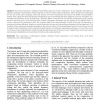Free Online Productivity Tools
i2Speak
i2Symbol
i2OCR
iTex2Img
iWeb2Print
iWeb2Shot
i2Type
iPdf2Split
iPdf2Merge
i2Bopomofo
i2Arabic
i2Style
i2Image
i2PDF
iLatex2Rtf
Sci2ools
IAJIT
2011
2011
Multilayer model for Arabic text compression
: This article describes a multilayer model-based approach for text compression. It uses linguistic information to develop a multilayer decomposition model of the text in order to achieve better compression. This new approach is illustrated for the case of the Arabic language, where the majority of words are generated according to the Semitic root-and-pattern scheme. Text is split into three linguistically homogeneous layers representing the three categories of words: derivative, nonderivative and functional words. A fourth layer, called the Mask, is introduced to aid with the reconstruction of the original text from the three layers in the decoding side. Suitable compression techniques are then applied to the different layers in order to maximize the compression ratio. The proposed method has been evaluated in terms of the rate of compression it provides and its time efficiency. Results are shown along with real texts to illustrate the performance of the new approach. The novelties of...
Compression Techniques | Distributed And Parallel Computing | IAJIT 2011 | Multilayer Model-based Approach | Suitable Compression Techniques |
| Added | 14 May 2011 |
| Updated | 14 May 2011 |
| Type | Journal |
| Year | 2011 |
| Where | IAJIT |
| Authors | Arafat Awajan |
Comments (0)

